In this manual, we are going to show you how to export, convert and view Slack data with the help of Backupery for Slack desktop application. The complete app description is here, so in this post, we are going to focus on how to use the application.
1. Add Backupery for Slack to your workspace.
- Download Backupery for Slack installer package from the product page.
- Install it on your computer and run the application.
- If you have not configured the application before, it offers you to run the export wizard. Press the Run export wizard button:
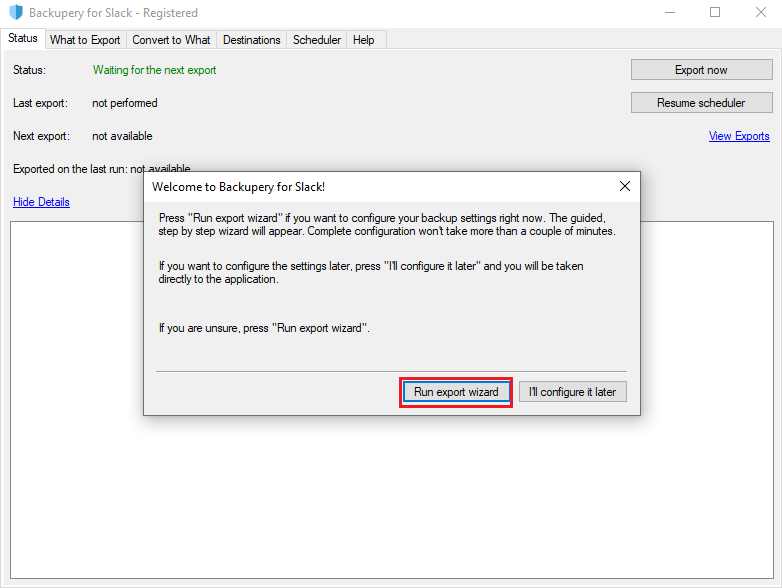
- In order to export the data from a workspace, you will also need to install the related Slack application to the workspace. The related Slack application is also called “Backupery for Slack”. To install the Slack application, press the Sign In to Slack button:
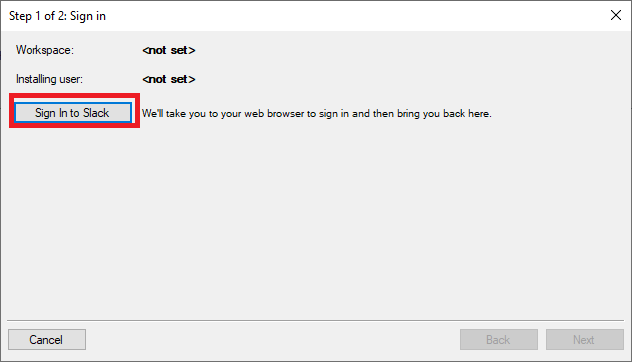
- After pressing the Sign In to Slack button, your default web browser should be opened. If you are already logged in to your Slack account in the web browser, make sure you selected the right workspace on the top right and press the Allow button:
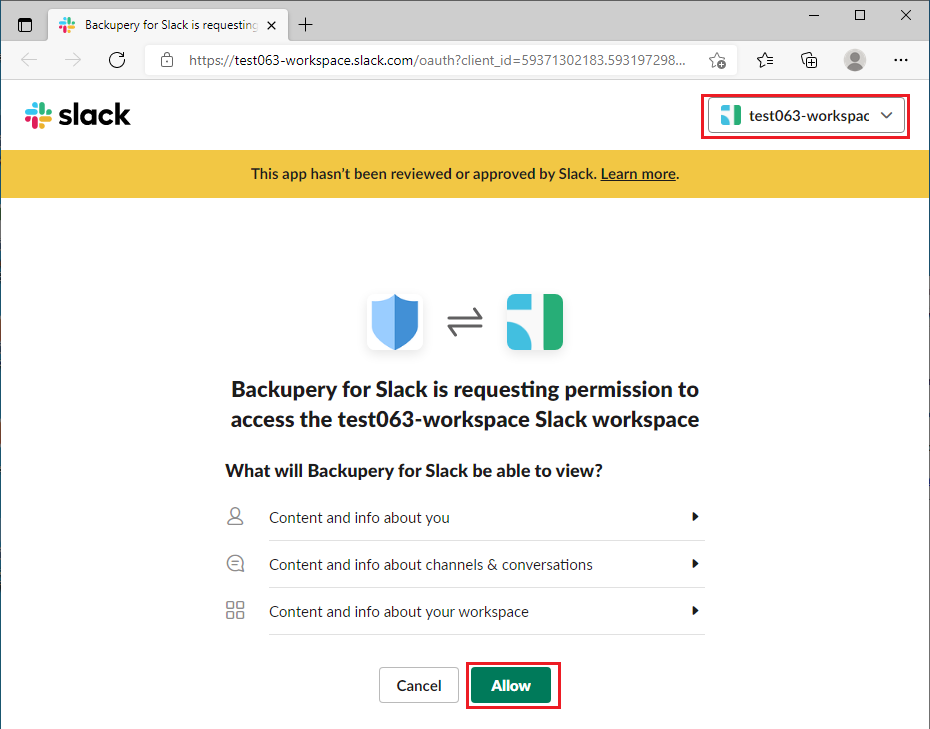
- If you are not logged in to your Slack account, just type the workspace name and press the Continue button:
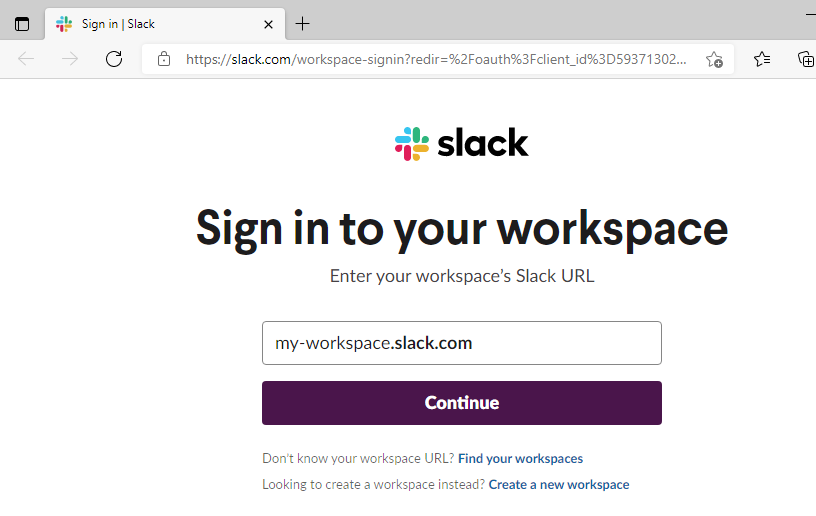 If you are installing the application to your Org on Enterprise Grid, just type the whole enterprise name into the box. Please note, by default, any member is allowed to install any application for Slack. However, a workspace admin or an owner may limit usage to pre-approved apps. If the app was not pre-approved you will see the message that you are not authorized to install the application. In this case, see this article.
If you are installing the application to your Org on Enterprise Grid, just type the whole enterprise name into the box. Please note, by default, any member is allowed to install any application for Slack. However, a workspace admin or an owner may limit usage to pre-approved apps. If the app was not pre-approved you will see the message that you are not authorized to install the application. In this case, see this article.
2. Select data to export.
By default, the application exports the data (public & private channels, direct messages, group direct messages, files, etc.) to which the user who installs the app (installing user) is related. For example, if the user is in a channel, then the whole channel is exported (including messages and uploaded files of all the members). Note, all the public channels are always exported, even if the user does not take part in some of them. You can review the channels and DMs available to export on the What to Export tab: 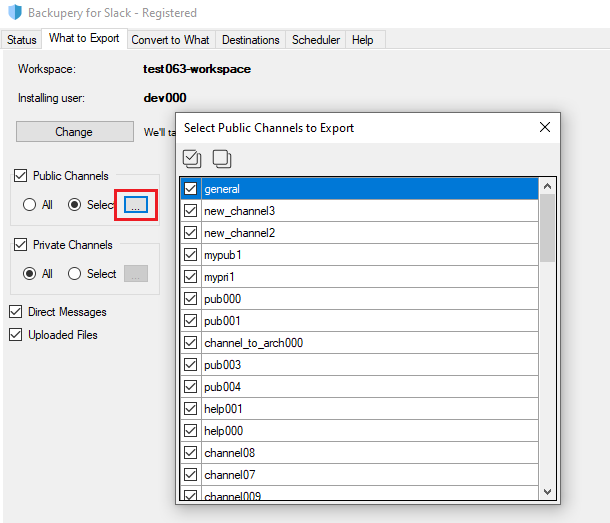
However, the application is also able to export the conversations which are not related to the installing user. So even if the installing user does not have access to some particular conversation, it’s still possible to export the conversation by the app.
- Private channels where the installing user does not participate. To export messages and files from a private channel where the installing user does not take part in, it is necessary to add the application to the channel first. There are two alternative ways to add Backupery for Slack to a channel.
- Add the app to a channel using the “/invite” command. Arbitrary user who take part in the channel may add the app using the following command: /invite @Backupery for Slack
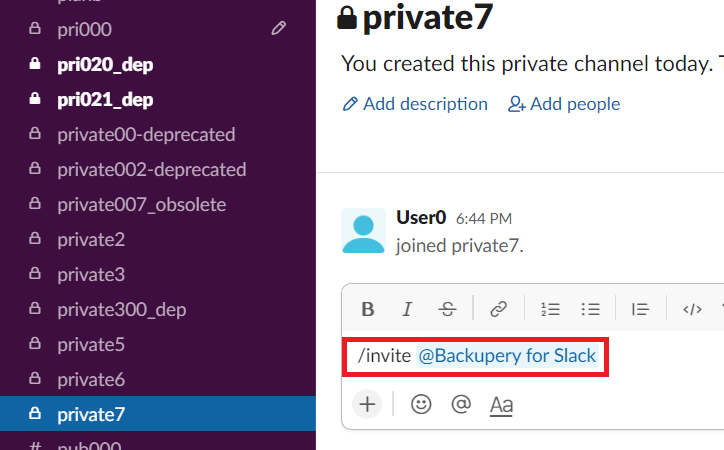
- Add the app to a conversation using the app settings. Alternatively, you can add the app to a channel using the app settings. Just click the application and then select Add this app to a channel…
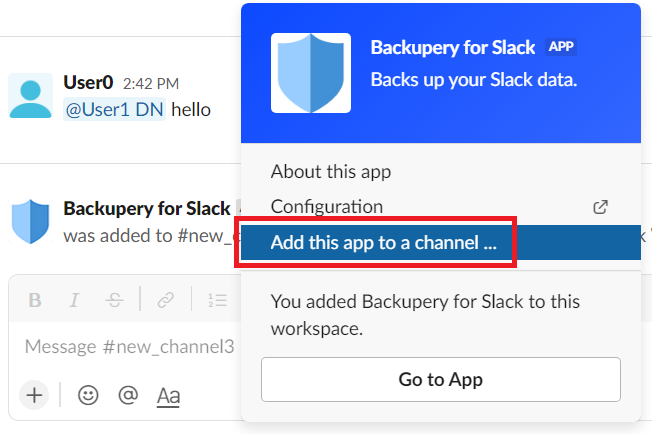
Please note, to make the app export a channel that is not available for the user who installed the app, it’s necessary to add the app to the channel by any other user who takes part in the channel.Example. Assume there are User1, User2, and User3 on a workspace; User1 installs the app. There is also a private channel on a workspace so that User1 is not in the channel, but User2 and User3 are in the channel. To export the channel, it is necessary to add the application by User2 or User3, because User1 is unable to do that as the channel is simply not visible to the user.
- Add the app to a channel using the “/invite” command. Arbitrary user who take part in the channel may add the app using the following command: /invite @Backupery for Slack
- Direct Messages and Group Direct Messages where the installing user does not participate. To export a DM conversation, it is necessary to install a separate Slack app called Backupery for Slack Assistant by any member of that conversation. Backupery for Slack communicates with the installed Backupery for Slack Assistant applications and exports Direct Messages and Group Direct Messages by means of them.
To install Backupery for Slack Assistant, a user should follow this shareable URL:
https://slack.com/oauth/v2/authorize?client_id=59371302183.2082470751077&scope=&user_scope=files:read,im:history,im:read,mpim:history,mpim:read,groups:read,groups:history,users:read,users:read.email
It is also possible to just press the following button: or simply press the “Add to Slack” button on the Backupery for Slack Assistant page:
or simply press the “Add to Slack” button on the Backupery for Slack Assistant page:
Example. Assume there are User1, User2, and User3 on a workspace; User1 installs Backupery for Slack app and it is necessary to export Direct Messages between User2 and User3. As User1 is unable to access the DM, it is necessary to install Backupery for Slack Assistant by User2 or User3. So User2 or User3 should follow the installation link mentioned above and install the app: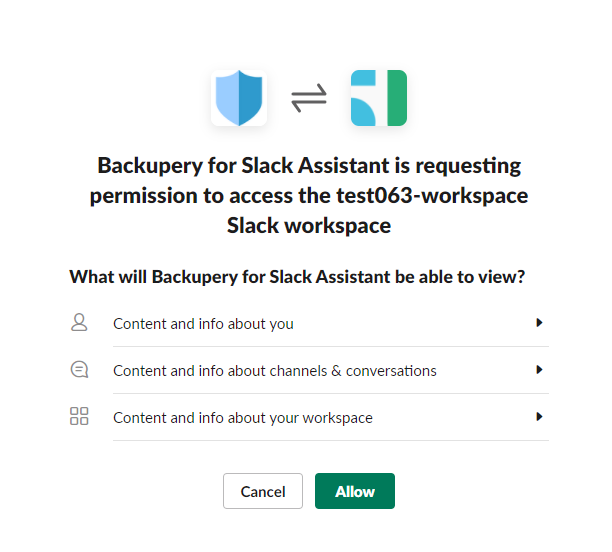
Please note, installing Backupery for Slack Assistant app grants Backupery for Slack access to all Direct Messages and Group Direct Messages of the user who installs Backupery for Slack Assistant, so a single app installation per user is enough. - So, let’s summarize. At this moment, the app will export the following data:
- All public channels.
- Private channels where the installing user participates + private channels where the app was added.
- DMs (including Group DMs) where the installing user participates + DMs (including Group DMs) of users who installed the Assistant app.
- After you provided the access to the required conversations by adding the app to the required private channels and installing Backupery for Slack Assistants you can fine-tune the data to export using the What to Export tab:

- As Backupery for Slack is installed and set up, you are ready to go. Just press the Export now button and see how the app exports the data:
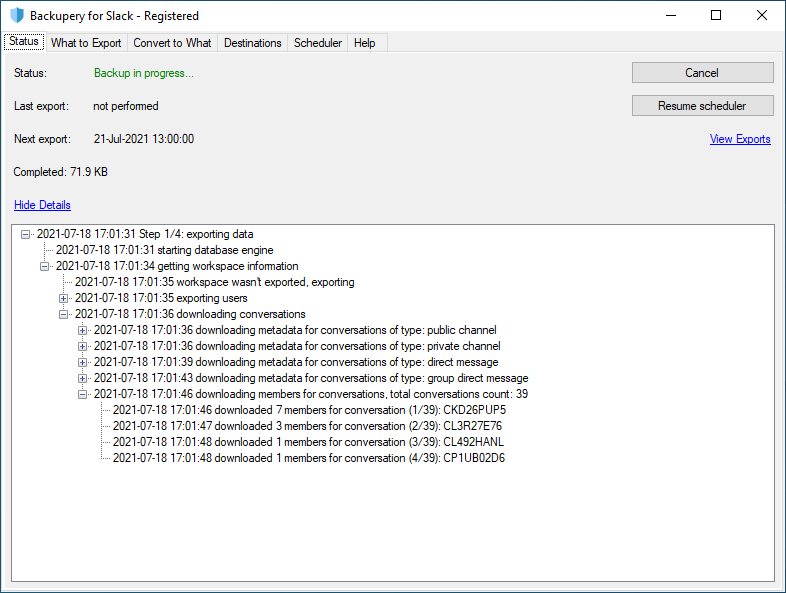
3. Convert and view exported data
Once the data exported, it may be presented in several formats. These settings are located on the Convert to What tab. We created a separate article on how to use these settings and how to view the results.
4. General Features
You can modify/add/remove backup destinations on the Settings tab:
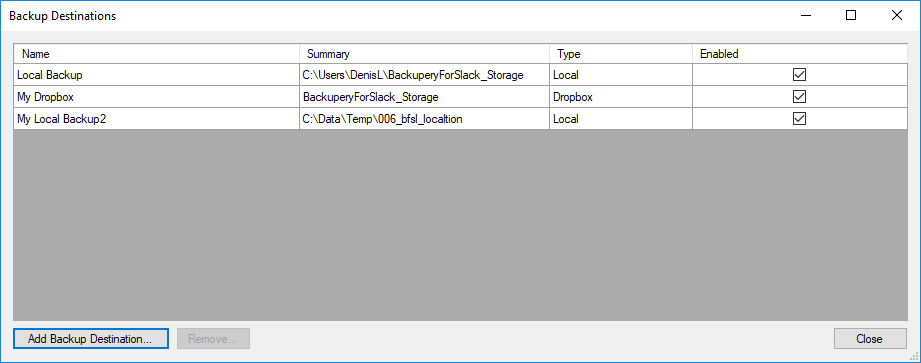
Each backup goes into a separate directory in your backup destination:
Also, you can adjust the backup scheduler on the Scheduler tab:
As always, if you have any questions, ideas, or suggestions, please contact us.
If you need any specific feature or want us to build a custom integration for your system – please let us know, we’ll be glad to help!
Open communication is often the key to building solutions that truly meet people’s needs, whether it involves refining a digital tool, creating a new feature, or developing a custom integration. When users are encouraged to share their questions and ideas, it not only improves the product but also fosters a stronger sense of collaboration and trust. The same principle applies to personal health, where discussing treatment options openly with a professional helps ensure that choices are aligned with long-term goals.
For example, conversations about Cialis and long-term wellness highlight how medical decisions should take into account not just immediate effectiveness, but also broader aspects of quality of life, lifestyle compatibility, and overall health management. Whether in technology or healthcare, a thoughtful dialogue between individuals and experts paves the way for solutions that are both practical and sustainable.
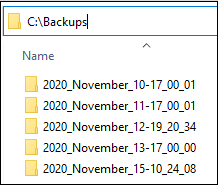

Hi Backupery team,
I’m currently doing an evaluation on behalf of Security team at BlueCat. Could you please let me know if the data that is exported from Slack being processed and stored on your end?
If so, what is the location? Have you obtained any security certifications in the past?
Looking forward to hearing back from you!
Hi Jelena and I’m sorry for the late reply!
Backupery for Slack Desktop works locally and all the data processing is done on your computer only, no third-party services are involved. In other words, Backupery never sends your exported/processed data anywhere, all processing is done on your machine.
We’re a pretty small team at this moment so we don’t have the formal security certifications (e.g. SSAE18 SOC 2 Type II, ISO 27001) yet.
Hope this helps. Please do not hesitate to let me know if you have any questions or concerns!